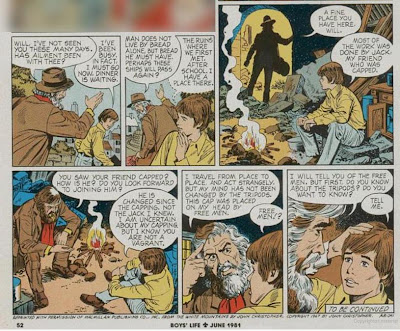 I never was a Boy Scout, and can count the number of times I went camping or fishing on one hand, but as a child, I still read Boy's Life magazine semi-regularly. After all, Boy's Life isn't just for scouts, but for all boys. So says the "O"!
I never was a Boy Scout, and can count the number of times I went camping or fishing on one hand, but as a child, I still read Boy's Life magazine semi-regularly. After all, Boy's Life isn't just for scouts, but for all boys. So says the "O"! Among the useful tidbits I gleaned from its pages were how to care for and repair audio cassettes (wouldn't want my collection of open-air recorded TV theme songs to get ruined through careless handling and storage, would I?) and how to build a hot-plate from two coffee cans, a rolled up piece of cardboard, and some melted candle wax (and yes, I actually built such a hot-plate, and fried a few burgers on it in the backyard, letting the grease drain right into the lawn. Good times.)
Among the useful tidbits I gleaned from its pages were how to care for and repair audio cassettes (wouldn't want my collection of open-air recorded TV theme songs to get ruined through careless handling and storage, would I?) and how to build a hot-plate from two coffee cans, a rolled up piece of cardboard, and some melted candle wax (and yes, I actually built such a hot-plate, and fried a few burgers on it in the backyard, letting the grease drain right into the lawn. Good times.)But my favorite part of Boy's Life was the comic book serial adaptation of John Christopher's Tripods trilogy, a series of science fiction books for children, consisting of The White Mountains (1967), The City of Gold and Lead (1968) and The Pool of Fire (1968) (a prequel, When the Tripods Came, was released in 1988).

The table of contents entry for the first installment of the Tripods adaptation. And a story by Robert Newton Peck in the same issue? Score!
Set in a ruined England, in which technology and culture has regressed to something resembling the 18th century after an invasion by aliens, piloting towering, three-legged crafts (not unlike those from H.G. Wells' War of the Worlds) has turned the people of earth into compliant serfs via brainwashing "caps" attached to the scalp, the Tripods trilogy follows the adventures of several boys who join a resistance group hidden in the Swiss Alps, to infiltrate and eventually repel the invaders.
The stories were adapted as a series of single page chapters (artist is Frank Bolle), appearing in Boy's Life from May 1981 to August 1986, but never made available or collected in any other format.
Here's the entire* first book, The White Mountains, originally appearing in issues May 1981 through July 1982 (*
Click any page to embiggen, or browse complete issues at Google books, here.






















































